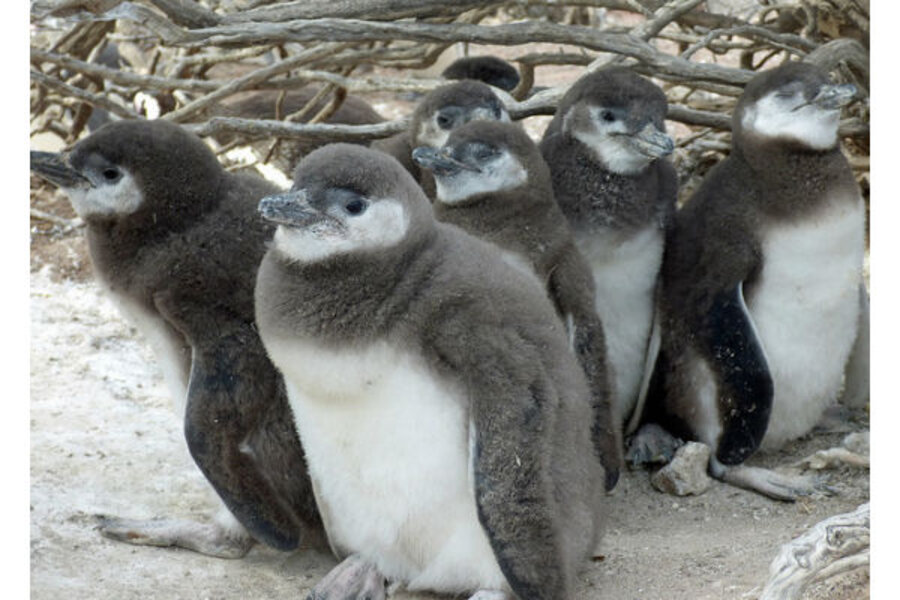Climate change putting penguin chicks at risk, scientists say
Loading...
Penguin-chick mortality rates have increased in recent years off the coast of Argentina — a trend scientists attribute to climate change and expect to worsen throughout the century, a new study finds.
From 1983 through 2010, researchers based at the University of Washington in Seattle monitored a colony of roughly 400,000 Magellanic penguins living halfway up the coast of Argentina on a peninsula called Punta Tombo. Each year, the researchers visited penguin nests once or twice a day from mid-September through late February to assess the overall status of the colony and the health of the chicks once they hatched in late November or early December. [Gallery of Magellanic Penguin Colony]
The resulting data set provides one of the longest-ever records of a single penguin colony. It revealed that starvation and predation were the most common and consistent chick killers over the years, but that hypothermia was the leading cause of death during years with heavy rainstorms, which became more prevalent throughout the study period — a trend that is consistent with climate models projecting the effects of climate change in the region.
Facing extremes
Young chicks between 9 and 23 days old were particularly vulnerable to hypothermia, as they were too young to have fully grown their waterproof plumage but already too big to seek shelter under their parents' bodies, the team reports today (Jan. 29) in the journal PLOS ONE.
"They have to have waterproof feathers to survive," study co-author Dee Boersma told LiveScience. "If chicks don't have waterproof plumage, they are going to die as soon as they end up in the water."
Extreme heat — another component of climate change expected to worsen throughout the century — also challenged chicks' temperature-regulation systems and resulted in deaths, though not as many as hypothermia did, the team reports.
David Ainley, a senior wildlife ecologist at ecological consulting firm H.T. Harvey & Associates who studies Antarctic penguin colonies, says that, aside from giving Magellanic chicks the chills, rain can also damage the burrows that they live in during their early days.
"I think that [penguin] pairs that have good burrows probably wouldn't suffer much of an effect, but it might be harder for pairs that have not competed successfully for where to make their burrow," Ainley, who was not involved in this study, told LiveScience. "Shallow burrows, or no burrow at all — those would be the ones that are most affected by rain."
Climate-change connection
The team noted that not all rainstorms killed the chicks. Of the 233 storms that occurred over the course of the study period, only 16 resulted in chick deaths. Still, the researchers pointed out that the types of heavy storms that did result in mortalities are projected to become more frequent, with some climate models predicting an increase in extreme precipitation in the Southern Hemisphere summer by 40 to 70 percent between 2076 and 2100, compared with that seen between 1951 and 1976.
Though the researchers only analyzed a single Magellanic colony in the study, they expect that colonies of the same species elsewhere along the coasts of Chile and Argentina likely react similarly to changes in weather patterns.
Wayne Trivelpiece, an Antarctic penguin researcher with the National Oceanographic and Atmospheric Administration's Southwest Fisheries Science Center, based in La Jolla, Calif., agrees that climate change is a serious threat to these and other penguin populations around the world. He has spent nearly the past 40 years studying penguins in Antarctica, and said he has also seen a decline in populations that he feels comfortable attributing to the indirect effects of climate change.
"I don't think it is a real stretch to make that kind of connection," Trivelpiece told LiveScience. "But the actual hard evidence will come many decades down the road."
Follow Laura Poppick on Twitter. Follow us @livescience, Facebook& Google+. Original article on LiveScience.
- Happy Feet: A Gallery of Pudgy Penguins
- Photos of Flightless Birds: All 18 Penguin Species
- Image Gallery: Sex Habits of Penguins
Copyright 2014 LiveScience, a TechMediaNetwork company. All rights reserved. This material may not be published, broadcast, rewritten or redistributed.





